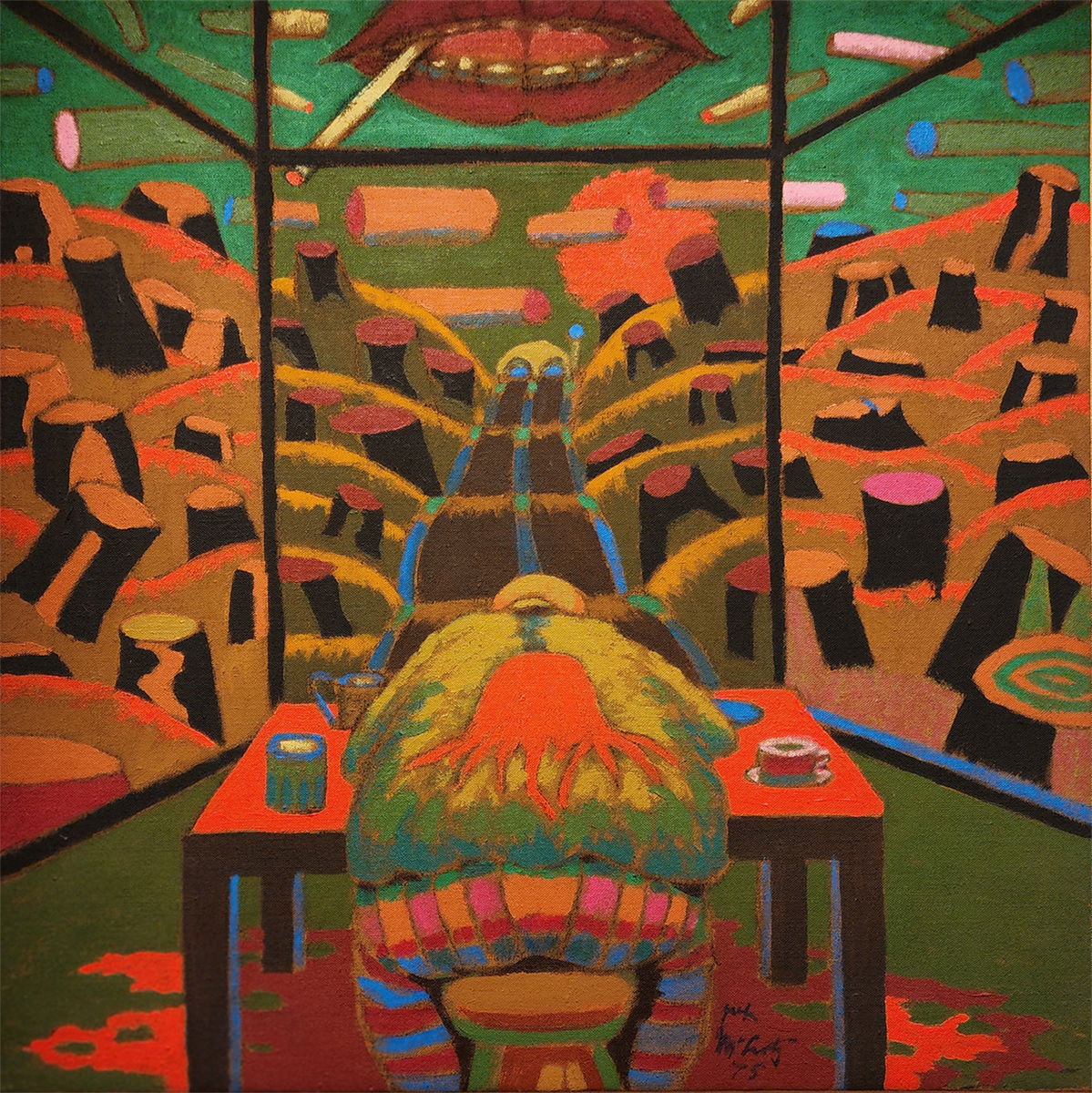Director’s Notes Issue No.3
The Trouble With Giants
Jack McLarty, Breakfast at Clearcut, 1975, oil on canvas, 24” x 24”, MoNA Permanent Collection, gift of Manuel Izquierdo Trust
On the occasion of completing upgrades to the museum’s HVAC system and building’s roof, the exhibition Re Building which opened on August 5, celebrates the Museum of Northwest Art’s permanent collection and its role writ large in building up and cementing the reputation of the institution as a remarkable repository of the modern and contemporary trajectory of Northwest art. As we celebrate better and safer conditions for preserving the art of the Northwest region, we are reminded that the permanent collection is a living document that honors our culture's past and continues to tell our story into the future.
Sometimes, the past catches the present’s youthful arrogance by surprise and with one picture reminds him of his lack of perspective. There is a painting in Re Building that, when taken in today’s context, is exactly that: a lesson in perspective. At present, we live in a historical moment in which the future looms over us with its ecological and climate endgame. The future is a cliffhanger, quite literally. I belong to a generation who grew up with comics in which the future used to be exciting and astonishing, we even had time to imagine flying cars swooshing through the canyons slicing through mile-high skyscrapers. What I am struggling with today is my memory of a scintillating future when I was a child, let’s say seven, already in second grade. That was the year 1975. Sure, the future was bright back then for me, and why shouldn’t it be for a seven-year-old kid instinctively shielded by his parents from the ugliness of the world? But already then, there were cracks starting to appear in the collective imagination. It would be a mistake to believe today that back then we were not aware of what we, as a species, were doing to nature, and in turn to ourselves, as if in 1975 we were so entrenched in the modernist narrative of endless progress that we swept overconsumption and exploitation of natural resources under the rug of the dream of flying cars. True, back then that narrative was still so pervasive, that some of us thought we were already flying. Yet, sometimes falling (when it is free and protracted) feels a lot like flying. Back to the future in 1975, in my second-grade classroom: my teacher Marita is talking about the Yanomami of Brazil whose lives are being displaced and destroyed by the deforestation of the Amazon. I still remember that day so vividly. It is seared in my brain: first it was the name “Yanomami” which with its foreign sound captured my young imagination, then the realization that the devastation of the Amazon forest must have been immense as the teacher laid a cut out of Italy over the map of the basin of the Amazon river: Italy was so small! She was giving me a way to measure the proportions and the seriousness of the problem. She was giving me perspective. Of course back then I was not connecting the dots of deforestation and fossil fuels leading to the rising of temperatures and the ensuing consequences of climate change at a global scale.
Jack McLarty, Giant in Trouble, n.d., acrylic on canvas, 49.25" x 37.25", Willamette University, Hallie Ford Museum of Art Northwest Art Collection, Gift of Jack and Barbara McLarty (image source: digitalcollections.willamette.edu)
It was the year 1975 and Seattle-born, Portland-based artist Jack McLarty (1919-2011) then 56—my age today—painted Breakfast at Clearcut. This unimposing 24” x 24” oil painting on canvas features a chubby giant (a recurring character in McLarty’s work: see Giant in Trouble in the collection of the Hallie Ford Museum of Art) sitting on a stool at a breakfast table, his broad back to the viewer seemingly admiring the view outside a bay window. From a first look, this character appears funny and humorous—just take a look at his striped clown trousers. The colors on the canvas augment this feeling of gayety. As we look past his figure, we have the impression to be looking out from inside an observatory or a fish tank. Outside, the rolling hills—masterfully rendered by lines of mustard yellow and grapefruit pink—are polka-dotted with tree stumps: their round cuts marking the surface of the earth like inflamed pustules on the skin—a hot pink one on the right—eye candy—calls for attention, as much as the green of the spiraling growth rings of another stump. Smack in the center, a road lined in azure, parts the hills like Moses parted the Red Sea delivering us to the promised land of an undisclosed future, waiting beyond sight where the sun is rising (or is it setting? Note to self: the title says Breakfast, so we know it is rising). In a teal-emerald sky, the orange sun is a circular saw blade, cigarette butts fly like my cars of childhood memory, and a disembodied mouth hovers like a flying saucer: All my favorite things in a comic. I am enthralled. I am a kid again. What I love about this picture is its color saturation: cadmium orange, teals, yellows, pink and blue have strong chroma (no neutrals here) and capture the eye of the viewer from afar, inviting to come closer, to look, to partake in this confetti busyness of the picture plane. What happens when I look? I am no longer in 1975. I am back in the present, aware of what we are doing to the planet. Since 1975 Breakfast at Clearcut has made us guests at the giant’s breakfast: we look outside the window with him, we see the outcome, does that make us complicit? No…well, maybe. Since 1975, with its warm and fuzzy, cartoon-like colors, Breakfast at Clearcut has been asking the viewer to acknowledge the ugliness of our impact on nature. McLarty’s environmental sensibility was ahead of his time; His consummate ability to craft an image of destruction with the accessibility of a candy-like palette. We can see this in other works such as Hungry Baby or Cars, which address humans’ unleashed greed and unhealthy appetites.
Jack McLarty, Hungry Baby, oil on canvas, 36” x 36’ (image source: mutualart.com)
Jack McLarty, Cars, 1970’s, oil on canvas, 36” x 36” (image source: invaluable.com)
Jack McLarty (image source: mclarty.org)
Born in Seattle in 1919, William James “Jack” McLarty was one of Oregon’s veteran modern painters. His work relates to Surrealism and German Expressionism. McLarty’s work was included in the exhibition Recent Painting USA at the Museum of Modern Art, NY in 1962 and Art of the Pacific Northwest at the Smithsonian American Art Museum in 1974. His work is in the collections of the Portland Art Museum, Seattle Art Museum, Jordan Schnitzer Museum of Art (University of Oregon) and Hallie Ford Museum of Art (Willamette University), as well as the Museum of Northwest Art.
Stefano Catalani
Executive Director & Chief Curator | Museum of Northwest Art





